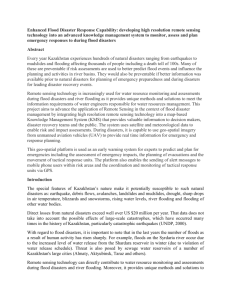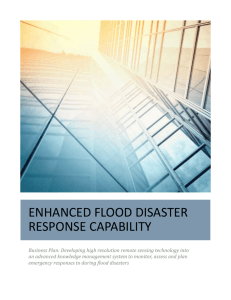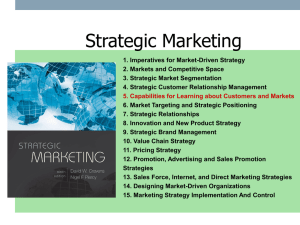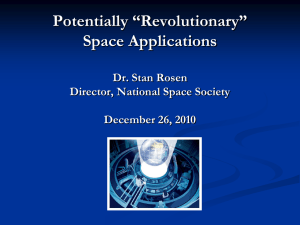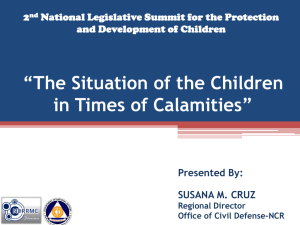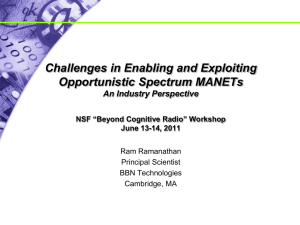PowerPoint
advertisement
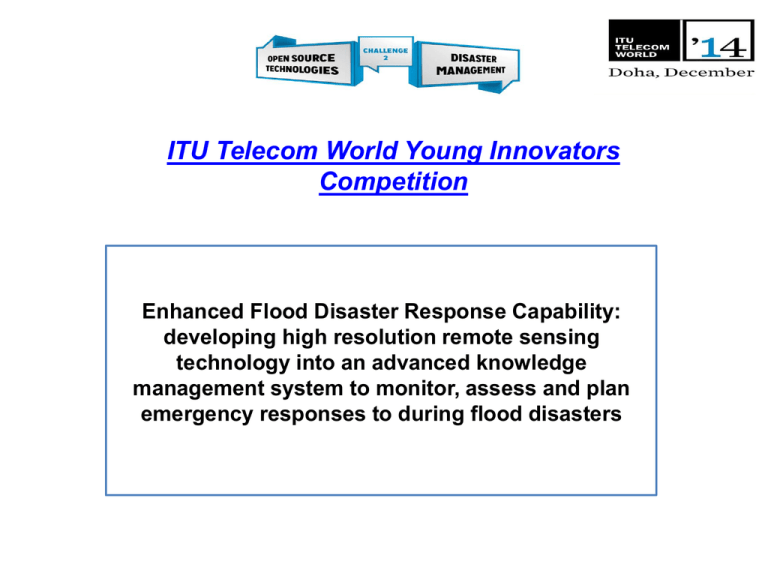
ITU Telecom World Young Innovators Competition Enhanced Flood Disaster Response Capability: developing high resolution remote sensing technology into an advanced knowledge management system to monitor, assess and plan emergency responses to during flood disasters DESCRIPTION OF THE PROJECT Every year Kazakhstan experiences hundreds of natural disasters ranging from earthquakes to mudslides and flooding affecting thousands of people including a death toll of 100s every year. Many of these are preventable if risk assessments are used to better predict flood events and influence the planning and activities in river basins. They would also be preventable if better information was available prior to natural disasters for planning of emergency preparedness and during disasters for leading disaster recovery events. Remote sensing technology is increasingly used for water resource monitoring and assessments during flood disasters and river flooding as it provides unique methods and solutions to meet the information requirements of water engineers responsible for water resources management. This project aims to advance the application of Remote Sensing in the context of flood disaster management by integrating high resolution remote sensing technology into a map-based Knowledge Management System (KMS) that provides valuable information to decision makers, disaster recovery teams and the public. The system uses satellite and meteorological data to enable risk and impact assessments. During disasters, it is capable to use geo-spatial imagery from unmanned aviation vehicles (UAV) to provide real time information for emergency response planning, This geo-spatial platform is used as an early warning system for experts to predict and plan for emergencies including the assessment of emergency impacts, the planning of evacuations and the movement of tactical response units. The platform also enables the sending of alert messages to mobile phone users within risk areas and the coordination and monitoring of tactical response units via GPS. • Kazakhstan is located in the center of the Eurasian continent and enters into ten greatest on the area of the countries of the world. Its area is 2,7 million square kilometers. • In Kazakhstan there is a great number of the rivers. Mainly they have the average and small size. The largest rivers are Irtysh, Ural, Tobol, Ishim, Syrdarya and Ili. During spring thawing snow the volume of flow of these rivers sharply increases, sometimes more than 1000 times. They can overflow banks and flood large territories. • Thus, development of technologies of space monitoring of water objects is in interests of regional emergency departments for modeling of potential extreme situations (flood, break of dams, washout of coast, etc.) by using remote sensing data . Figure 1. Main regions of Kazakhstan with high risk of flooding JUSTIFICATION • It is crucial to integrate local knowledge, GIS and maps into the process of disaster risk management. There are three main reasons for this integration: (i) a hazard map plays a key role in disaster risk identification, and it is an effective tool in making local knowledge visible; (ii) local knowledge is essential for disaster risk management; and (iii) GIS maps have advantages over conventional maps. First, hazard maps are fundamental to the development of a community-based methodology for collecting and displaying the disaster vulnerabilities and risks that comprise the core content of local knowledge (Hatfield,2006). • Hazard mapping is one of the first steps of producing a community vulnerability inventory. The flood disaster mapping can contribute to proper planning and resource allocation for disaster preparedness. DEVELOPMENT OBJECTIVE • The objective of this research and engineering project is to develop a webbased GIS knowledge management software for – water resources assessment and monitoring, and – emergency response planning and monitoring • The application is used for – Conducting flood risk assessments – Providing valuable information for disaster recovery planning and recovery to emergency response units – Providing valuable information to the public • The application requires – Integrate remote sensing technology into a knowledge and communication platform – Obtain Remote sensing data and develop software algorithms to synthesize hydrological data – Conduct research on flood potential of rivers for the development of geospatial flood risk maps KNOWLEDGE MANAGEMENT FRAMEWORK A conceptual water resources knowledge management framework has been developed to enquire and collect relevant information for water resources management and decision making. The framework was developed by understanding and mapping water resource management and decision making processes in the Committee of Water Resources – a government agency responsible for water resources management in Kazakhstan. The framework includes nine (9) distinct but interrelated components. These are shown in Table 1. TABLE 1. Components of Water resources knowledge management framework Water resources knowledge management framework Water Resource Strategy and Policy Stakeholder Management Ownership, Responsibility, Authority and Resources Inventory of the water resource and its infrastructure Condition and Performance of a water resource and its infrastructure Valuations and Financial Review Monitoring, Control and Knowledge Management Internal Process Development and Review Risk Assessment, Management, and Emergency Response KNOWLEDGECAPABILITY MANAGEMENT ANALYTICAL FORFRAMEWORK RISK Figure 2. Development and application of algorithms SOFTWARE CAPABILITY AND INTEGRATION • Web-based Geographic Information Systems platform • Information input from Remote Sensing Technology – signal processing using algorithms – geospatial mapping • Mapping of GPS positions from emergency response units and cell GPs-enabled mobile phones • Information dissemination to GPS-enabled mobile phones specific to defined geographic areas MARKET • The system described herein is currently non-existent; • Clients: Ministry of the Environment and Water resources, KazhydroMet, emergency services, armed forces • The need for this IT solution has been described in the decree for water Resources management signed into legislation in 2014 by the President Nazarbayev; COMMERCIALIZATION PART Once we have a prototype of the web-based software application established, we will register a Limited Liability Company that will offer a web-based software and data subscriptions to our customers. Currently, we are targeting one particular client segment: any government agency involved in water resources management and emergency response authorities and NGO’s operating t in the field of disaster management and recovery One of the biggest tasks is to rebuild that knowledge of the water resources systems in Kazakhstan and make them less vulnerable to changes within Government agencies. This is achieved with our software solution which will capture data on water resources in Kazakhstan and store them in a highly secured data warehouse for as long as the information is needed. Once this information has been generated it is available over a secure web access to any user in the subscribing agency. As part of the subscription, new information that is generated with new satellite data and our algorithms will be stored in the secure data ware house and is made available via the web portal to customers. New information will be generated based on the overflight frequency of KazEOsat-1 and KazEOsat-2 which is 2 weeks for any given location in Kazakhstan. COMMERCIALIZATION PART • As it shown in Figure 1. the web-based subscription service offers continuous information services for the information we developed with our algorithms and makes this information available at a mouse click. • The knowledge management systems makes these electronic data available to our subscribing customers and eliminates any need for information stored on paper. Therefore, we improve access to information which will lead to better and faster decision making processes when it comes to water resources management. COMMERCIALIZATION PART In summary, there is a strong argument this application as it will significantly improve water resources decision making and emergency response planning and recovery. Needless to say, that our technology integration with remote sensing and knowledge management can be applied to many other clients using the same technology. Here is a listing of potential clients and their uses of the remote sensing processing and knowledge management architecture: • Ministry of the Environment for Land use management but also aquatic pollution monitoring • Ministry of Agriculture and irrigation and commercial agro-businesses for crop management • Ministry of Transportation, urban centers for Highway monitoring and management and traffic The overall budget for launching the business is $336,000.00 which includes all the research and development costs. Currently, we have no funding for starting up the research and development Launching a sustainable project will require initially $10,000.00 for the first phase of development and includes a dedicated software developer or an off-the-shelf web-based GIS solution as a platform for presenting remote sensing data. An additional $30,000 is required for testing and further refinements if the proof of concept is proven functional and reliable. This also covers legal fees, office space and a business development budget. BUDGET & PREDICTIONS Rate US 120 Project Management 80 WP 3 - Remote Sensing 120 120 120 120 WP 4 - Knowledge management 40 120 120 120 WP 6 - Final Report & Dissemination of Results 40 80 Sum Hours Sum Labour cost Finance & Administration (10%) Total 80 80 80 24 320 24 240 240 $33,600.00 $57,600.00 $2,880.00 $36,000.00 $36,000.00 Equipment Expenses Total Labour cost RK Committee for Water Resources JSC «National Company «Kazakhstan Gharysh Sapary» Total hours $0.00 $21,600.00 640 $91,200.00 $4,560.00 $50,000.00 $145,760.00 480 $72,000.00 $3,600.00 $15,000.00 $90,600.00 144 $22,080.00 $25,000.00 $0.00 $47,080.00 80 280 Total 120 120 150 150 120 180 Alex James – Software Engineering, NU Yau Hee, electronics engineering, NU Auelbek Zauirbek, Water resources management Roland Bradshaw Dina Kaskina, Principal TABLE 2. Budget distribution 80 $9,600.00 $12,000.00 160 $9,600.00 $19,200.00 $194,880.00 $45,160.00 $65,000.00 $30,504.00 $335,544.00 CORE TEAM Project Manager, Entrepreneur: Dina Kaskina is a research officer and environmental applications specialist. E-mail:dina.kaskina@nu.edu.kz Dr. Roland Bradshaw, Nazarbayev University – Principal Investigator Roland A Bradshaw earned his Doctorate in Engineering at Cranfield University (UK) in 2008. His Master of Sciences in Water Resource Technology and Management was earned at The University of Birmingham (UK) in 2001. Prior to that, he completed his undergraduate studies in Environmental Engineering in 2000 earning a German Engineer Diploma with distinction. Dr. Bradshaw has more than 12 years of experience encompassing research, design and construction as well as consultancy assignments specializing in asset risk assessments for municipal infrastructure, including roads, bridges, water supply systems, wastewater collection systems and water and wastewater treatment plants. Dr. Bradshaw has a strong research interest in sustainable infrastructure management as well as risk management specific to water and environmental engineering. Dr. Alex James Nazarbayev University (NU) – Co-Principal Investigator (Remote sensing algorithm development / Knowledge Management Software)He has obtained his doctoral degree from Griffith University, completing in short 2 year duration, and was funded through international Australian Research Council fellowship. He was associated as a researcher with Griffith University, IIIT, UC Berkeley, HCL, Intel and QsSemi. He has over 13 years of experience in industry and academia with developing memristive computing, neural computing and learning systems, large data decision fusion systems, brain inspired logic design and cognitive algorithms. He is an adjunct professor at IIIT and CEO of the startup Enview R&D Labs LLP. He was one of the recipients of IEEE International Outreach funding from IEEE Circuits and Systems Society in 2012 and was awarded top reviewer of Pattern recognition letters. He has grants for research in applied machine intelligence and neural computing (2011-2013), biometric internet of things (2013-2014), Indian Language Corpra Initiative (ILCI) Phase 2 Department of Info. Technology, Govt. of India 2012-2013, virtual resource center for language computing Govt. of Kerala, 2011-2013. He is a Senior Member of IEEE. Dr. Yau Hee Kho Nazarbayev University (NU) – Co-Principal Investigator (Remote sensing signal /image processing) Thank you for your attention!
